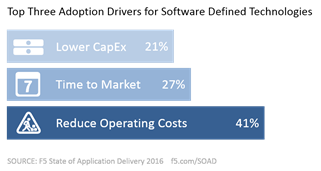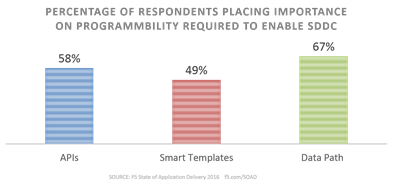L'état de la distribution d'applications dans le SDDC est stimulé par VMware et F5

Après avoir observé le flux et le reflux des tendances technologiques au cours des dernières années, j’en suis arrivé à la conclusion que le tout premier facteur qui motive l’adoption d’une nouvelle technologie est une question de coûts. Lorsque le cloud a été introduit pour la première fois, de nombreuses enquêtes nous ont montré que les « économies de coûts » étaient la principale raison pour laquelle les organisations l’adopteraient. Aujourd’hui, les principaux facteurs déterminants sont passés du coût à l’agilité et à l’évolutivité.
Le centre de données défini par logiciel (SDDC) - et ses cousins SDN et SDX et même DevOps - sont actuellement dans les phases naissantes de maturité et suivent cette règle (désormais écrite) : les économies de coûts sont le principal moteur de l'adoption. Mais comme le montre notre enquête 2016 sur l’état de la fourniture d’applications , ces économies ne proviennent pas nécessairement des coûts fixes traditionnels (le matériel physique que nous appelons « capex ») mais plutôt des coûts « indirects » d’exploitation d’un centre de données ; les frais généraux « de maintien de l’alimentation » que nous appelons « opex ».
Juste derrière, un « coût indirect » émergent, jusque-là inconnu de la plupart des centres de données : celui du « délai de mise sur le marché ». C’est un terme souple, car le coût d’une incapacité à arriver sur le marché en temps voulu ne peut être estimé qu’en termes de perte potentielle de revenus, de notoriété de la marque et de part de marché. Mais ces coûts sont réels et ils sont intimement liés à la capacité d’une organisation à commercialiser rapidement les applications et les services dont elle a besoin pour non seulement maintenir son activité, mais également encourager sa croissance.
SDDC propose de répondre à ces deux souhaits en exploitant la technologie pour automatiser la gestion et orchestrer la fourniture des services d'application essentiels à la livraison réussie des applications à leur destination finale : les utilisateurs, qu'ils soient consommateurs ou entreprises.
Cette technologie, bien sûr, est la programmabilité. Ce sont les API et les modèles qui pilotent l’intégration ainsi que l’automatisation nécessaire pour « définir par logiciel » le centre de données. Sans surprise, compte tenu des principaux facteurs favorisant la technologie définie par logiciel dans notre enquête, les attitudes concernant l’importance de ces outils programmatiques sont restées élevées, avec près de 60 % indiquant que les API étaient importantes et près de la moitié marquant les modèles intelligents comme importants.

Ce n’est pas surprenant. La programmabilité est l’élément fondamental sur lequel s’appuient des technologies comme SDDC pour atteindre l’efficacité des opérations nécessaire pour réduire les dépenses d’exploitation et la vitesse requise pour améliorer les délais de mise sur le marché.
C'est pourquoi F5 et VMware travaillent continuellement pour faire progresser l'intégration entre VMware NSX et F5 BIG-IQ Cloud. En permettant aux opérations d'automatiser le provisionnement et le déploiement des services d'application définis par logiciel (SDAS) F5 sur lesquels les organisations comptent pour fournir des applications rapides, sécurisées et disponibles, les applications peuvent être livrées sur le marché aussi rapidement et efficacement que possible.
Les administrateurs VMware NSX peuvent désormais provisionner ces services d’application pour une machine virtuelle sans quitter la console NSX Manager. BIG-IQ Cloud s'intègre à NSX pour exposer le riche ensemble de services d'application F5 aux administrateurs réseau et de virtualisation, offrant ainsi la virtualisation réseau SDAS et NSX à partir d'un point de vue administratif unique.
Cela est réalisé via des API des deux côtés de l’intégration qui permettent aux deux systèmes de partager des informations et des données importantes pour le provisionnement rapide et efficace et la mise à l’échelle rapide de SDAS dans l’ensemble du centre de données. Les modèles intelligents qui décrivent SDAS peuvent être exposés aux administrateurs, permettant un provisionnement en libre-service qui améliore le flux de travail de déploiement et réduit le délai de mise sur le marché. L’utilisation de modèles favorise également la standardisation des politiques de livraison qui permettent d’éviter les erreurs de configuration coûteuses et de réduire les étapes manuelles répétitives, réduisant ainsi les coûts opérationnels.
Comme indiqué dans notre enquête, la programmabilité du chemin de données est également considérée comme importante par la majorité (67 %) des répondants. 83 % de nos clients ne se contentent pas de le dire dans les sondages, ils le mettent en pratique en utilisant iRules pour personnaliser la diffusion des applications au quotidien. L’investissement dans la programmabilité n’est pas quelque chose que vous jetez, qu’il s’agisse d’une application métier critique ou d’un service d’application critique. C'est pourquoi il est important de noter que nous accordons une attention particulière à la protection de cet investissement en permettant aux iRules et iApps F5 sur lesquels les organisations comptent d'être maintenues et réutilisées via BIG-IQ Cloud et via cette solution, NSX.
Les services d’application sont omniprésents dans chaque organisation. Ils assurent l’évolutivité, la sécurité et l’optimisation des applications (mobiles, cloud, héritées et Web) sur lesquelles les entreprises s’appuient de plus en plus pour assurer leur réussite dans cette économie des applications. Mais cette économie numérique évolue rapidement, ce qui signifie que les organisations doivent agir plus rapidement et plus efficacement. Aujourd’hui, cela nécessite une mise sur le marché plus rapide avec des pipelines de déploiement plus simples qui optimisent non seulement la livraison des applications et des services d’application, mais également les budgets. En tirant parti de la programmabilité pour intégrer des solutions, standardiser la livraison et automatiser le provisionnement et la gestion, vous pouvez optimiser en toute confiance VMware NSX avec F5 en activant le SDDC dont vous avez besoin pour réussir.
Pour plus d'informations sur nos solutions VMware NSX avec F5 :
· VMware NSX avec services de distribution d'applications F5
